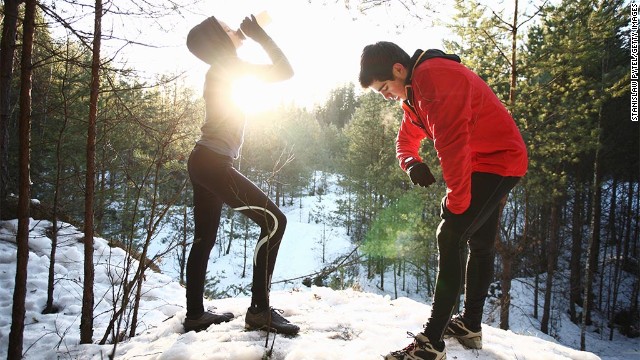
Sof McVeigh, author of ‘Treat Yourself Natural’, shares three recipes for cosmetics you can make using ingredients from your garden this winter
Winter is the time to hunker down and make the most of what you have gathered over the year. Don’t worry if you didn’t collect much; there are still many evergreen herbs available to use, such as rosemary and sage.
This is also the time of year when the kitchen spice rack comes into its own: cinnamon, ginger and cloves all make great cold busting remedies.
With the cold winter days this is a fantastic time of year for indoor activities and making presents is a fun way to keep out of the cold – even after Christmas. Try making ginger chocolates, relaxing bath salts or invigorating body scrubs. Whatever gifts you choose to make, adding a personal label and a pretty ribbon makes all the difference, so let your creativity run wild.
Sage makes a good toner for oily skin due to its antibacterial and astringent properties. Create your own oily skin toner with sage, witch hazel (to tighten the pores) and rosemary (to increase circulation to dull skin). Also for a lovely smell add either rose essential oil to soothe, or lavender essential oil to cleanse. Apply nightly with cotton wool, although it is important to carry out a skin sensitivity test before using for the first time. Once made up, this skin toner will last for three months.
What you need
• 200ml (7fl oz) still spring water
• 4 tsp (20ml) glycerine
• 2 tsp (10ml) sage tincture*
• 1 tsp (5ml) witch hazel tincture*
• 1 tsp (5ml) rosemary tincture*
• 5 drops of rose essential oil or lavender essential oil
1. Mix all of the above in a bottle.
2. Use nightly with cotton wool.
Winter body scrub
This was one of the first ‘potions’ I ever made and is incredibly easy; it also makes a great present with the addition of a pretty ribbon and label. Body scrubs are great for reviving dull winter skin: the salt sloughs away dead skin and the oil moisturizes it. Depending on the herbs you use, a body scrub can be invigorating or relaxing. Your herb choice is personal: you can choose ones whose scent you like, or you can choose them for their benefits. Mint, eucalyptus and rosemary or sage work well together as a winter decongestant body scrub, which is also invigorating and warming.
You can use this as a body scrub or add a spoonful to a hot bath rather like bath salts. However please don’t use it if you have sores or cuts, as it will really sting. If you can’t find some of the herbs or plants, just add a few drops of their essential oil instead.
What you need
To make enough to fill two 300ml (10fl oz) jam jars:
• 600ml (20fl oz) fi ne sea salt, or enough to fill both your jars
• Approximately 3 sprigs of rosemary, or 20 sage leaves, 30 mint leaves and 20 eucalyptus leaves
• 650ml (1¼ pints) olive or sunfl ower oil, to fill both your jars plus a little extra
• Pan
• Sieve lined with muslin
• 2 clean jars and labels
1. Roughly chop the plants and put them in a pan.
2. Cover them with oil and warm them on a very low heat for one hour. Do not even simmer, as the idea is just to warm the contents, encouraging the plants to release some of their goodness into the oil.
3. Line a sieve with muslin and drain the mixture into a bowl, keeping the oil; the leaves can be thrown away.
4. In another bowl pour in your sea salt, then slowly stir the oil into the salt until it reaches a consistency where the salt has completelyabsorbed all the oil. Keep any left over oil in a jar for later use.
5. Finally, spoon into clean jars and label.
6. This will last for up to one year, though the smell may start to go.
Alternative herbs
To make your own unique scrub you could try some other ideas:
• Marigold (calendula) makes a healing skin scrub.
• Lavender or chamomile creates a relaxing and soothing one.
• Honey, with it natural antibacterial properties, will add an extra element to any body scrub, as well as providing it with a great consistency and smell.
• As well as changing the herbs you use, you can also replace the salt with any of the following: sugar, ground almonds, ground oats, ground rice, bran, jojoba exfoliating grains, or apricot kernel powder. The latter two are even smooth and gentle enough to use on your face
Witch hazel spot gel
This recipe makes a strong gel to put on individual spots only, as it is very drying. Always carry out a skin sensitivity test before using.
What you need
• 40ml (1½fl oz) water
• 40ml (1½fl oz) homemade witch hazel decoction*
• 1 tsp xanthum gum
• 5 drops of tea tree oil
• 5 drops of lavender essential oil
• 12 drops of Preservative 12, used in the vegan food industry in Denmark (optional)
• Small, clean pot, approximately 80ml size
1. First add the witch hazel decoction to the water.
2. Sprinkle on the xanthum gum, whisking it in well so there are no lumps.
3. Add five drops of tea tree oil for its antibacterial properties then five drops of lavender essential oil for its lovely smell and antibacterial properties.
4. Then add 12 drops of Preservative 12 if you want the gel to last; if you don’t use this, the gel will last for a week.
5. Pour the gel into a small pot and dab it on a spot when you need to.
TINCTURES
Make a tincture with any part of the plant you choose: put it in a jar, cover it with strong 40 per cent proof vodka and then let it soak for at least two weeks. The alcohol extracts the beneficial properties of the plant and acts as a preservative; if you don’t like the idea of using alcohol, you can substitute it with vinegar. Tinctures last a long time – on average three to four years – and they can be used either externally, or internally for some plants.
DECOCTIONS
Decoctions are easy to make, using just water. Boil the plant in water for between 15 to 20 minutes so that all the goodness from the plant is extracted into the water. Once boiled, drain and throw away the plant and use the liquid either externally, or internally for some plants. The best parts of the plant to use for making decoctions are the ‘tough’ ones: the roots, woody stems, bark, seeds and berries. As decoctions are water-based, bacteria grows in them so they don’t last as long as tinctures and vinegars: either use them straight away or add a preservative, such as sugar or citric acid. Decoctions are the base for many syrups and jellies, and are also useful for some skincare recipes.
Source: The Telegraph








